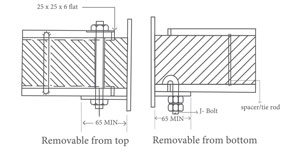intimate contact between the vapour and liquid
phases is necessary. Pakcol made from crimped mesh
of woven wire filaments provides a large surface
to realize the desired inter-phase mixing.
Mechanism
Capillary action of the strands of Pakcol Columns
helps in spreading the liquid uniformly over the
wire mesh. As a result, there is no build-up of
the liquid anywhere in the voids of the packing.
Vapour, therefore, has a free access to every
surface inside the packing. The high separation
efficiency is thus obtained as the available
surface of the packing is most effectively
utilized.
Salient Features
• Low value of HETP (Height Equivalent of
Theoretical Plate):
Typical values range from 100 to 150 mm. Low
values of PDTS (Pressure Drop per Theoretical
Stage). Typical values range from 0.04 to 0.05 mm
of Hg, depending on the vapour load.
• High vapour handling capacity:
Vapour handling capacity of Pakcol is comparable
to 25 mm metal pall rings
• No reduction in efficiency even at low liquid
irrigation rates:
Capillary action of Pakcol Columns helps it to
achieve uniform wetting of the entire package even
at low liquid loadings. Packing can work without
the loss of efficiency at a liquid irrigation rate
as low as 0.3 mh (0.5 GPM/FT).
• Performance is independent of Packing Size:
Unlike random packings, the properties of Pakcol
Columns are independent of packing size. Hence,
its performance characteristics, such as HETP and
PDTS, are practically independent of packing
diameter.
• No wall effect:
Pakcol draws liquid from the wall of the column
into its interior by capillary action. No liquid
redistributors are therefore necessary for a
column packed with Pakcol.
Advantages
Although Pakcol Column Packing appears to be
expensive, it will prove to be the most economical
solution to your problem if you weigh each of its
following advantages.
• Reduction in packed volume:
This is achieved due to low HETP of the packing
• Reduction in the cost of the column shell and
supporting structure:
This follows as a consequence of the lower packed
volume.
• Saving in energy cost:
This is possible through a reduction in the reflux
ratio.
• Reduction in product loss through product
degradation:
The use of Pakcol allows you to achieve reboiler
temperatures for a specified column top pressure.
A lower reboiler temperature reduces the rate of
degradation of heat-sensitive materials present in
the reboiler, resulting in high product yield.
• High flexibility:
Since Pakcol shows high performance over a wide
range of liquid loadings, it is most suitable for
the situations which demand flexibility, such as
batch operations, unsteady state operations and
multipurpose distillation jobs.
• Increased in throughput capacity:
The wide range of operating velocities allows an
increase in column capacity that is 2 to 2.5
higher than conventional packing.






